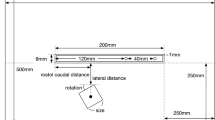Summary
Three weakly electric fish (Gnathonemus petersii) were force-choice trained in a two-alternative procedure to discriminate between objects differing in their electrical characteristics. The objects were carbon dipoles in plexiglass tubing (length 2.5 cm, diameter 0.6 cm). Their electrical characteristics could be changed by varying the impedance of an external circuit to which they were connected (Fig. 1). In one (the ‘capacitance dipole’) the resistance was very low(< 3 Ω) and the capcitance variable. In the other (the ‘resistance dipole’) the resistance was variable and the capacitance low (<50 pF).
Capacitances from several hundred pF (‘lower thresholds’, Fig. 2) to several hundred nF (‘upper thresholds’, Fig. 3) could be discriminated from both insulators and good conductors. In all cases the reward-negative stimulus was the capacitance dipole, which was avoided by all fish spontaneously. Thresholds were defined at 70% correct choices.
The fish were then tested for their ability to discriminate between one object with a given capacitance and another with resistances varying from 3 Ω to 200 kΩ. The capacitance dipole continued to be the negative stimulus throughout. All 3 fish avoided it in at least 80% of the trials at each stimulus combination (Fig. 4). This result suggests that Gnathonemus perceives the capacitance and the resistance of objects differentially.
The effect of the dipole-objects as well as some natural objects on the local EOD was recorded differentially very close to the fish's skin (Fig. 5). The amplitude of the local EODs was affected by all types of objects as they approached the skin. However, the waveform was changed only by capacitance dipoles and some natural objects (Figs. 6 and 7). It appears that the fish perceive not only intensity changes in the local EOD but wave-form deformations as well and can thus distinguish objects of different complex impedances.
Similar content being viewed by others
Abbreviations
- EOD :
-
electric organ discharge
- f max :
-
maximal spectral frequency
- GP :
-
Gnathonemus petersii
- LFS :
-
local filtered signal
- PMA :
-
probing motor act
- S+:
-
positive stimulus
- S :
-
negative stimulus
References
Bastian J (1977) Variations in the frequency response of electroreceptors dependent on receptor location in weakly electric fish (Gymnotoidei) with a pulse discharge. J Comp Physiol 121:53–64
Bastian J (1986) Electrolocation; behavior, anatomy, and physiology. In: Bullock TH, Heiligenberg W (eds) Electroreception. John Wiley & Sons, New York Chichester Brisbane Toronto Singapore, pp 577–612
Bastian J (1987) Electrolocation in the presence of jamming signals: behavior. J Comp Physiol A 161:811–824
Belbenoit P (1970) Conditionnement instrumental de l'électroperception des objets chez Gnathonemus petersii (Mormyridae, Teleostei, Pisces). Z Vergl Physiol 67:192–204
Bell CC (1990) Mormyromast electroreceptor organs and their afferent fibers in Mormyrid fish. III. Physiological differences between two morphological types of fibers. J Neurophysiol 63:319–332
Bell CC, Grant K (1989) Corollary discharge inhibition and preservation of temporal information in a sensory nucleus of mormyrid electric fish. J Neurosci 9:1029–1044
Bell CC, Russel CJ (1978) Effect of electric organ discharge on ampullary receptors in a mormyrid. Brain Research 145:85–96
Bell CC, Zakon H, Finger TE (1989) Mormyromast electroreceptor organs and their afferent fibers in Mormyrid fish: I. Morphology. J Comp Neurol 286:391–407
Bennett MV1 (1971) Electroreception. In: Hoar WS, Randall DJ (eds) Fish physiology, vol V, Sensory systems and electric organs. Academic Press, New York London, pp 493–574
Feng AS, Bullock TH (1977) Neuronal mechanisms for object discrimination in the weakly electric fish Eigenmannia virescens. J Exp Biol 66:141–158
Gellermann LW (1933) Chance orders of alternating stimuli in visual discrimination experiments. J Genet Psychol 42:206–208
Harder W (1972) Nachweis aktiver (elektrischer) Ortung bei Mormyridae (Teleostei, Pisces). Z Tierpsychol 30:94–102
Harder W, Schief A, Uhlemann H (1967) Zur Empfindlichkeit des schwachelektrischen Fisches Gnathonemus petersii (Mormyriformes, Teleostei) gegenüber elektrischen Feldern. Z Vergl Physiol 54:89–108
Heiligenberg W (1973) Electrolocation of objects in the electric fish Eigenmannia (Rhamphichthyidae, Gymnotoidei). J Comp Physiol 87:137–164
Heiligenberg W (1975) Theoretical and experimental approaches to spatial aspects of electrolocation. J Comp Physiol 103:247–272
Heiligenberg W (1977) Principles of electrolocation and jamming avoidance in electric fish. A neuro-ethological approach. Studies in brain function, vol. 1. Springer, Berlin Heidelberg New York
Lissmann HW, Machin KE (1958) The mechanism of object location in Gymnarchus niloticus and similar fish. J Exp Biol 35:451–486
Meyer JH (1982) Behavioral responses of weakly electric fish to complex impedances. J Comp Physiol 145:459–470
Sachs L (1984) Angewandte Statistik (6. Aufl.). Springer, Berlin Heidelberg New York
Scheich H, Bullock TH (1974) The detection of electric fields from electric organs. In: Fessard A (ed) Electroreceptors and other specialized receptors in lower vertebrates (Handbook of sensory physiology, vol III/3). Springer, Berlin Heidelberg New York, pp 201–256
Scheich H, Bullock TH, Hamstra RH Jr (1973) Coding properties of two classes of afferent nerve fibers: High-frequency receptors in the electric fish, Eigenmannia. J Neurophysiol 36:39–60
Schwan HP (1963) Determination of biological impedances. In: Nastuk WL (ed) Physical techniques in biological research, vol VI. Academic Press, New York London, pp 323–407
Toerring MJ, Belbenoit P (1979) Motor programmes and electroreception in Mormyrid fish. Behav Ecol Sociobiol 4:369–379
Watson D, Bastian J (1979) Frequency response characteristics of electroreceptors in the weakly electric fish, Gymnotus carapo. J Comp Physiol 134:191–202
Author information
Authors and Affiliations
Rights and permissions
About this article
Cite this article
von der Emde, G. Discrimination of objects through electrolocation in the weakly electric fish, Gnathonemus petersii . J Comp Physiol A 167, 413–421 (1990). https://doi.org/10.1007/BF00192576
Accepted:
Issue Date:
DOI: https://doi.org/10.1007/BF00192576




